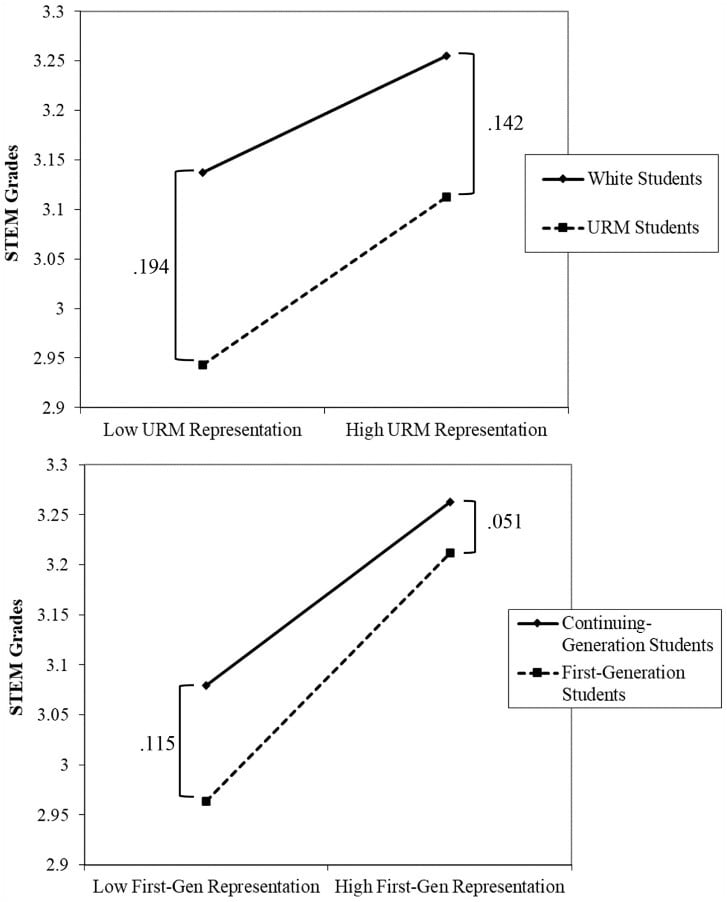You have /5 articles left.
Sign up for a free account or log in.

STEM courses with higher representation of first-generation and underrepresented minority students see students earning higher GPAs compared to courses with less representation, according to a new study.
gordonenkoff/iStock/Getty Images Plus
Across science, technology, engineering and math majors, Black, Latino and Native American students initially enroll at similar levels to their white peers but do not complete STEM degrees at the same levels.
There are a variety of factors prior to enrollment that may impact college students’ success, but the college environment can also shape outcomes and equity gaps, according to a new study published in AERA Open, the journal of the American Educational Research Association.
“Despite the presence of a voluminous literature on college student success, one potentially important environmental factor has largely been overlooked: the representation of ingroup peers within college courses,” researchers wrote.
The study, published Dec. 5, analyzed data collected by the College Transition Collaborative, evaluating over 11,800 students at 20 four-year institutions across the nation to measure how greater representation of underrepresented minority and first-generation students could benefit student grades.
Researchers from the University of Iowa, Renison University College in Canada, the University of Michigan at Flint, Washington State University and Indiana University showed that, when enrolled in a class with a greater number of peers like them, URM and first-generation students achieved higher grades compared to their peers enrolled in courses filled with predominately white or continuing-generation students. The students with privileged identities also benefited from the diversity of experiences, earning higher grades.
The study: The study explored how classroom representation of underrepresented minority and first-generation students predicts grades within STEM courses, as well as how representation can predict grades among students with privileged identities.
Data represented 11,688 students enrolled in 8,468 undergraduate STEM courses at 20 U.S. colleges and universities from fall 2015 to summer 2017. Most institutions enrolled predominantly white and continuing-generation students.
Researchers evaluated three questions:
- To what extent are the percentages of URM and first-generation students in STEM courses associated with college grades among STEM-interested students?
- How do these relationships between representation and grades vary as a function of students’ URM and first-generation identities?
- If grades vary as a function of URM and first-generation student identities, are there additional student-related (gender, SAT scores) or course-related (class size, field of study) attributes that further moderate these effects?
Using course-level and registrar data, researchers calculated the proportions of URM and first-gen students in a given course. The study did not gauge students’ majors or retention, only their grades, as that variable is highly related to retention and persistence in a STEM major.
The results: The data showed a positive and significant relationship between proportion of URM students in STEM courses and their grades, particularly among URM students themselves. The same relationship was evident for the number of first-gen students—the greater proportion of first-gen students predicted academic outcomes for all students, but especially first-gen learners.

When there was higher representation of underrepresented minority students in courses, grade disparities between URM and their white peers shrank 27 percent. High representation of first-generation students also promoted higher grades among first-gen students, with grade disparities diminishing 56 percent.
“It’s really notable that improving racial and socioeconomic representation leads to benefits for everyone and reduces inequities at the same time,” co-author Nicholas Bowman, a professor of educational policy and leadership studies at the University of Iowa, shared in a press release. “It is not a zero-sum game.”
Researchers theorize that the connection between representation and grades has to do with “identity safety” in courses with peers who hold the same identity as them—the URM and first-gen students feel less like they must represent their group in a space dominated by a privileged group.
Supporting URM Students in STEM
Other research has pointed to a need to support underrepresented minority students in their pursuit of science, technology, engineering and math careers.
A September study from Education Equity Solutions found professors’ pedagogical styles can improve Black and Latino students’ outcomes in an introductory college math course. A policy brief by Brookings found Black, Hispanic, American Indian and Alaska Native students were less likely to be enrolled in STEM majors, which could be related to restrictive change-of-major policies.
Changing course content can also bridge equity gaps between student achievement and maintain rigor.
So what? The study can be applied to the argument that racial, ethnic and socioeconomic diversity is beneficial to U.S. colleges and universities, according to the report. “Broadly speaking, the present work highlights the importance of mitigating or removing contextual barriers that inhibit the success of students with minoritized identities,” the study says.
Researchers believe that institutions with limited representation of URM or first-gen students may benefit from organizing courses to increase representation, but that would be less necessary or even counterproductive at institutions with greater diversity.
Future research should attempt to understand the positive effects of participating in a diverse course environment to leverage those strategies in spaces where representation is lower. Some solutions could be hiring teaching assistants from minoritized identity groups, highlighting work by minoritized researchers or creating group activities focusing on shared identity among students, as detailed in the report.
Is your institution researching equity gaps in grades? Share with us.




